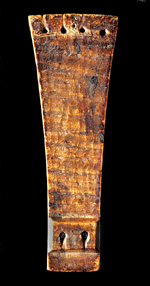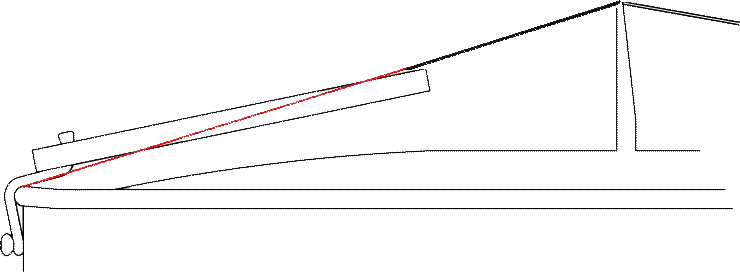|
When we think of what distinguishes the baroque violin from the modern violin we think of the straight neck and the fingerboard wedge which determines the projection of the strings to the bridge. The nut and the saddle are likely to be at the same height relative to the top of the violin. The nut to saddle distance forms the base of a triangle which is bisected by the bridge/arch height. |
|
| Now there are two triangles, one on each side of the bridge/arch. The distribution of the bridge pressure on either side of the bridge/arch is determined by respective string/bridge angles. |  |
| There are also forces in either direction at right angles to the top of the bridge. When the perpendicular forces are seen in balance, it is clear that the force in the direction of the nut is greater due to the sharper string/bridge angle on the tailpiece side. |  |
| So a violin built in the manner of the early baroque violin is inherently out of balance with regard to the geometry of the strings vis-ŕ-vis the bridge. Friction at the top and feet of the bridge hold it in place. But the bridge will not be in a state of equilibrium relative to the forces upon it. Picture this as a tiny man leaning against the bridge on the tailpiece side. When you consider that the bridge not only rocks, but must also flex and bend with each cycle of vibration, it becomes clear that a dis-equilibrium of these forces will have consequences for the response of the violin. One of the most obvious ways I have seen the response affected is the tendency for baroque violins to tolerate only light strings. This stands to reason since the imbalance will be proportional to the tension of the strings and heavier strings only worsen the situation. Ideally the static forces on the bridge are in balance. And in fact when theorists calculate these forces, they usually average the angles, discounting the difference between the two. But even with the modern violin, where the angles are closer to equal due to the higher appui and raised saddle, there will be, on balance, a kilogram or more of force pushing toward the nut. For a violin in baroque set up, the options are limited. Can we open up the angle of the strings at the bridge? This would certainly put the static forces closer to a state of balance. | |
 |
|
| The only way to create a larger angle between the strings and the bridge would be to raise the saddle, which is the only pivot point of consequence here. But raised saddles do not become part of violin set-up until the mid 18th century. What if we increase the size of the tailgut? Would that open up the string/bridge angle? Surprisingly, the answer is no. The size of the tailgut is a key variable in baroque violin set up, but tailgut thickness and string/bridge angle are not directly related. In fact the tailpiece string lengths will always form a line directly to the top of the saddle, no matter the size of the tailgut. |  Courtesy of the National Music Museum |
 Courtesy of the National Music Museum |
| Early tailpieces were fairly thick, between 5.5 - 6mm.
Perhaps there were structural reasons, depending on the choice of wood,
but there may have been other reasons as well. Violin makers as early as
Girolamo Amati (1613) began to carve out the forward section of the
underside of the tailpiece, preserving intact a thick section where the
tailgut passes through. Tailpieces of this type were very common during
the baroque yet today’s violinmakers rarely incorporate this detail
when they finish the tailpiece for a baroque violin. The drawing below illustrates the forces in play when the tailpiece and tailgut are of historical thicknesses. Note the continuous line of the strings from the crown of the bridge to the top of the saddle. The imperative of the strings to follow this line creates a pivot point where the tailgut exits the bottom of the tailpiece. As the strings are tightened the tailpiece rotates in a clockwise manner, bringing it into a more parallel orientation with the top of the violin. When this happens, the tailpiece is more flexible and appears to be capable of storing and releasing energy as the bridge flexes from the vibration of the strings. The static forces have not changed since the angle between the strings and the bridge are unchanged. But there appears to be a re-orientation of the dynamic forces that have a profound effect on the resonance of the violin. |
 |
| What role does the tailgut play in this system, and
why was a thick tailgut seen as an advantage? This would seem to be
counterintuitive if we are seeking greater flexibility in the tailpiece
system. But examining and measuring the holes in original tailpieces we
find tailgut thicknesses of 2.50 to 2.60. When tailgut of thinner
sizes is used, it quickly reaches the limit of its’ yield strength. In
other words the thinner material readily conforms to the line of stress;
particularly where it bends on exiting the bottom of the tailpiece,
resulting in a more rigid system. In contrast a thicker piece of tailgut
maintains a gradual curve as it passes through the tailpiece and most
importantly, retains its’ springy quality indefinitely. This attribute
of thick tailgut enables the rotational movement of the tailpiece and
enhances the dynamic qualities of the tailpiece system by providing it
with a spring hinge. This makes an enormous contribution to the damping
qualities of the bridge by permitting greater flexibility of movement.
I have experimented extensively with my own violin and can attest
that the results are dramatic. With the proper historical set-up the
violin rings louder and longer even when very heavy strings are used.
The tailpiece string lengths ring quite loudly as well and if they are
in tune with the playing lengths, will respond sympathetically as well.
In this set-up there is a pronounced gap between the strings and the
front edge of the tailpiece, creating a natural pure stop as the string
exits the hole. I believe that early makers conceived this type of tailpiece, in conjunction with the use of thicker tailgut, usually 2.5mm or greater, as key elements in the design of the violin. With this system in place the bridge is at once free to flex in either direction. Any remaining imbalance is overridden by friction at the top and at the feet of the bridge. Finally with these elements in place it is possible to string a baroque violin optimally with thicker strings for a full sound, rich in dynamic potential. As a practical matter it should be fairly easy to retrofit a tailpiece to achieve a better sound. Tailgut should be 2.5-2.6mm. I can certainly help with this. As for the tailpiece, we would like to see an overall thickness of 5.5mm where the tailgut passes through. So if your tailpiece is currently 4mm, as many seem to be, you can simply add a wood or cork shim behind the tailgut on the underside of the tailpiece. It does not have to be added to the front edge of the tailgut because the platform performs the function of a fulcrum where the rear edge of the tailpiece pivots at the point where the tailgut passes through. |
